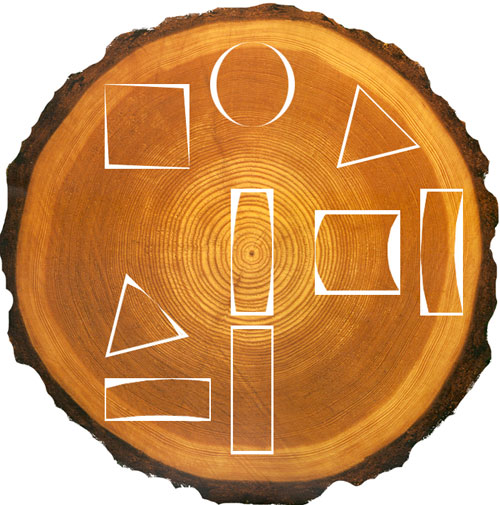Many wood joint techniques are dependent on but also benefit from the characteristic that wood is an anisotropic material. The material characteristics of wood are different in various directions of growth. This should be taken into account when joining different pieces of wood together. Adhesive surfaces where the wood grain structure is perpendicular to one another are often the cause of cracked cover plates and broken joints. Therefore, all predictable moisture changes should be taken into account in the structural parts of wood joints.
The trunk of a growing tree is equipped with a mechanism that transports water (sap) from the roots to the leaves. When the tree is felled, the liquid stops running but remains in the cell. A freshly felled tree has a moisture content of up to 40%. Wood sawn into planks and similar are air-dried to a moisture of 15-18%. This requires a drying time of 2-3 years, depending on the material thickness.
Thereafter, wood to be used for furniture and furnishings is generally machine-dried to a moisture content of 6-8%. Even after this, the moisture content of the wood does not remain constant. In the same manners as a sponge, wood absorbs moisture from the surrounding air and expands, or releases it while shrinking. This is the hygroscopic feature of wood.

Wood shrinks most in the direction of the annual rings of the trunk (tangentially) and only half of it shrinks against them (radially), i.e. from the core of the wood towards the outermost surface. In addition, heartwood changes less than surface wood. There is very little shrinkage in the growth direction of the tree. Thus, a tree expands and shrinks in relation to variability in the air humidity in a predictable manner. Existing knowledge and experience can be used to anticipate the amount of changes in advance and in a controlled manner. This avoids cracking, twisting and breaking of the wood.
Usually, the easiest and most natural solution is that the natural shrinking and expansion of wood are not hindered, but they are taken into account as early as in the structural design. Wood is stronger when stressed in the longitudinal direction of the grain than in the transverse direction. In turn, the radial stress is stronger than the tangential one. There are significant differences in the natural shrinking and expansion of different tree species, both quantitatively and temporally. Differences between species of wood should also be taken into account in their tolerance to stress.
The natural shrinking and expansion of individual boards 5-8 cm wide due to moisture is not very significant, so changes in the outer perimeter of the frame structure need not be taken into account. A solid wood panel between them has a larger surface area, so its shrinking and expansion in the width direction must be predicted structurally. Space for shrinking and expansion is left in the grooves of the frame to where the panel portion is fixed only in the middle to allow balanced shrinking and expansion in both directions.
Technical wood products (MDF, plywood and particle board) do not need to be prepared for moisture changes. The panel portion can be glued throughout into the groove of the frame.
In structures where all the sides have the same grain structure (ends meet), the shrinking and expansion of the wood does not need to be considered separately. Changes occur simultaneously in all structural parts, provided that they are of a similar tree species. In the case of structures with cross-sectional joints in the grain direction, their movement in the opposite directions should be taken into account, for example, with loose screw holes or non-adhesive dovetail groove joints. Whenever two pieces of wood meet so that the grains are in different directions, the joint becomes a challenge when conflicting forces are encountered.
Some joints, such as finger joints, exhibit small surface changes over time when one of the joints moves more in the longitudinal direction than the other. After a while, the joint surfaces will become noticeably staggered.